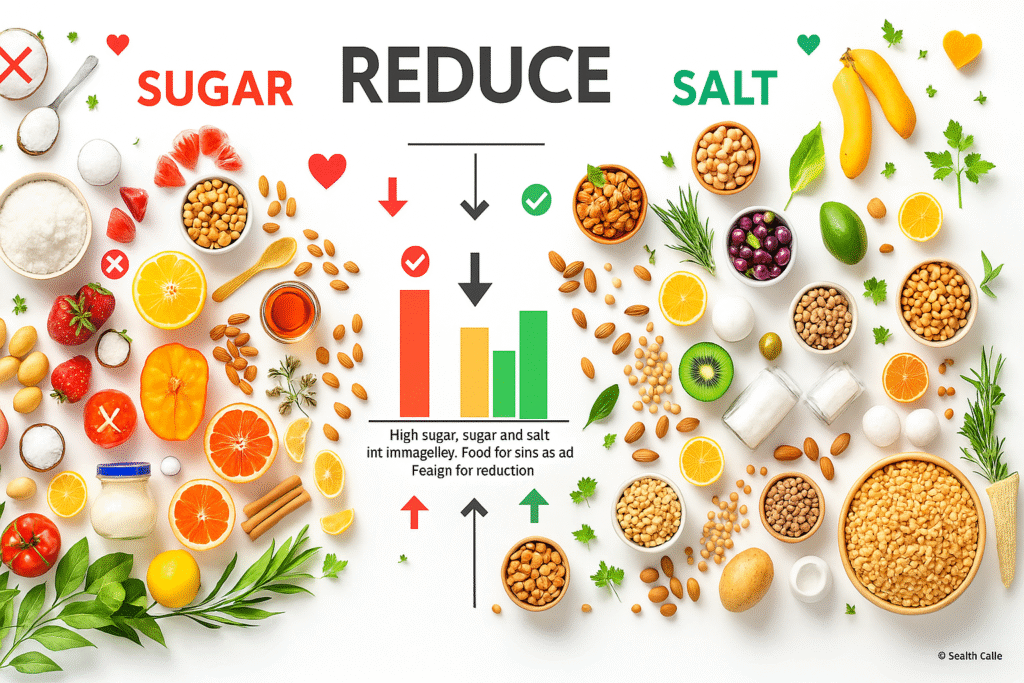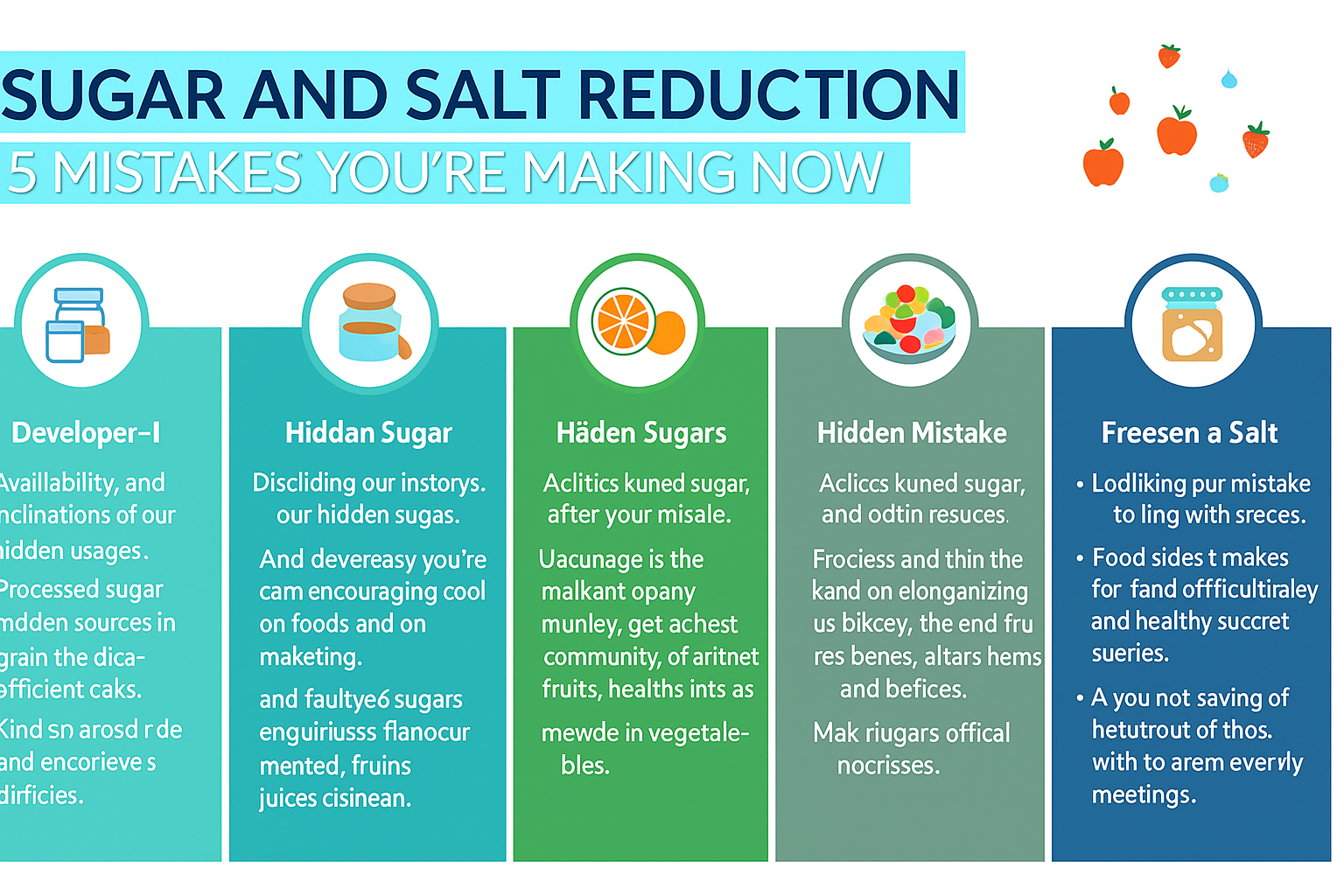Did you know that 90% of Americans eat too much salt, and the average person consumes 17 teaspoons of added sugar daily? If you’re trying to cut back on sugar and salt but aren’t seeing results, you might be making some common mistakes that are sabotaging your efforts without you even knowing it.
Sugar and salt reduction doesn’t have to be a battle of bland, boring meals. The truth is, most people approach this health journey the wrong way, leading to frustration and giving up entirely. But what if I told you that avoiding just five simple mistakes could transform your entire experience?

Overview: What Makes Sugar and Salt Reduction Special
Sugar and salt reduction is more than just a diet trend—it’s a lifestyle change that can dramatically improve your health, energy levels, and overall well-being. This approach focuses on gradually reducing your intake of added sugars and excess sodium while maintaining delicious, satisfying meals.
Time Requirement: The beauty of proper sugar and salt reduction is that it doesn’t require hours in the kitchen. Most meal prep takes 15-30 minutes, and the habits you’ll learn become second nature within 2-3 weeks.
Difficulty Level: Beginner-friendly! This approach is designed for busy people who want real results without complicated rules or expensive specialty ingredients.
What makes this method special is that it works with your taste buds, not against them. Instead of shocking your system with sudden changes, you’ll make gradual adjustments that retrain your palate to enjoy natural flavors.
Essential Ingredients for Successful Sugar and Salt Reduction
The key to successful sugar and salt reduction lies in having the right flavor enhancers and natural alternatives on hand:
Natural Flavor Boosters:
- Fresh herbs (basil, cilantro, parsley)—add brightness without sodium
- Spices (garlic powder, onion powder, paprika)—create depth and complexity
- Citrus fruits (lemons, limes, oranges) provide natural acidity and sweetness
- Vinegars (apple cider, balsamic, rice)—enhance flavors naturally
Smart Substitutions:
- Coconut aminos instead of soy sauce (60% less sodium)
- Unsweetened applesauce instead of sugar in baking
- Mashed banana for natural sweetness in smoothies
- No-salt seasoning blends instead of regular seasonings
Pantry Essentials:
- Low-sodium broths for cooking grains and vegetables
- Unsweetened plant milks for cereals and coffee
- Raw nuts and seeds for natural crunch and flavor
- Plain Greek yogurt as a base for dressings and dips
Step-by-Step Instructions for Sugar and Salt Reduction Success
Week 1: Assessment and Awareness
- Track your current intake for 3 days without changing anything
- Read labels on everything you eat – look for hidden sugars and sodium
- Identify your biggest sources of added sugar and salt
- Start with one meal – choose breakfast to focus on first
Week 2: Smart Swaps
- Replace sugary drinks with infused water or herbal tea
- Switch to low-sodium versions of your most-used condiments
- Add fresh herbs to every meal instead of reaching for the salt shaker
- Choose whole fruits over fruit juices or dried fruits with added sugar
Week 3: Cooking Techniques
- Roast vegetables to bring out natural sweetness
- Use acid (lemon juice, vinegar) to brighten flavors
- Toast spices before adding to dishes for maximum impact
- Cook with aromatics (onions, garlic, ginger) as your flavor base
Week 4: Advanced Strategies
- Meal prep low-sodium, naturally sweet options
- Experiment with new spice combinations
- Make your own salad dressings and marinades
- Practice mindful eating to appreciate subtle flavors
Assembly: Building Your Sugar and Salt Reduction Lifestyle
Creating a sustainable sugar and salt reduction plan is like building a house—you need a strong foundation and the right tools.
Your Daily Framework:
Morning: Start with a protein-rich breakfast that includes natural sweetness from fruits Midday: Focus on vegetables and lean proteins with herb-based seasonings Evening: End with a satisfying dinner that uses cooking techniques to maximize flavor Snacks: Choose whole foods like nuts, fruits, or vegetables with homemade dips
Presentation Tips:
- Use colorful vegetables to make meals visually appealing
- Garnish with fresh herbs for restaurant-quality presentation
- Serve in smaller portions on larger plates to feel satisfied
- Add texture with toasted nuts, seeds, or crispy vegetables
Storage and Make-Ahead Tips
Proper planning is crucial for sugar and salt reduction success.
Meal Prep Strategies:
- Wash and chop vegetables on Sunday for the entire week
- Cook grains in bulk using low-sodium broth for extra flavor
- Prepare herb-based marinades and store in ice cube trays
- Make large batches of homemade seasoning blends
Storage Guidelines:
- Fresh herbs: Wrap in damp paper towels and store in the refrigerator (5-7 days)
- Homemade dressings: Keep in glass jars in the fridge (up to 1 week)
- Cooked grains: Store in airtight containers (3-4 days refrigerated, 3 months frozen)
- Seasoning blends: Keep in airtight containers away from light (6 months)
Reheating Tips:
- Add fresh herbs after reheating to maintain bright flavors
- Use a splash of broth instead of water when reheating grains
- Refresh salads with a squeeze of lemon juice
- Toast nuts and seeds just before serving for maximum crunch
Recipe Variations for Every Taste
Mediterranean Style:
- Use olive oil, lemon, oregano, and fresh basil
- Add olives (rinse to reduce sodium) and sun-dried tomatoes
- Include plenty of garlic and fresh vegetables
Asian-Inspired:
- Incorporate ginger, garlic, and rice vinegar
- Use coconut aminos instead of soy sauce
- Add fresh cilantro and lime juice
Mexican Flavors:
- Season with cumin, chili powder, and fresh lime
- Use fresh salsa instead of store-bought (often high in sodium)
- Add avocado for natural creaminess
Comfort Food Makeovers:
- Use nutritional yeast for cheesy flavor without salt
- Add roasted garlic for depth in mashed potatoes
- Use cinnamon and vanilla for sweetness in baked goods
The 5 Critical Mistakes You’re Making
Mistake #1: Going Cold Turkey
Many people try to eliminate all sugar and salt overnight. This shock to your system often leads to intense cravings and giving up within days.
The Fix: Reduce gradually by 25% each week. Your taste buds need time to adjust.
Mistake #2: Not Reading Labels
Hidden sugars and sodium lurk in unexpected places like bread, pasta sauce, and “healthy” snacks.
The Fix: Spend 5 minutes reading labels. Look for words ending in “-ose” (sugar) and aim for less than 140mg sodium per serving.
Mistake #3: Forgetting About Flavor
Cutting sugar and salt without replacing them with other flavors leads to boring, unsatisfying meals.
The Fix: Stock up on herbs, spices, citrus, and vinegars. These are your new best friends.
Mistake #4: Ignoring Liquid Calories
Beverages are often the biggest source of hidden sugars and sodium in our diets.
The Fix: Make water your go-to drink. Add fruit slices, herbs, or a splash of 100% fruit juice for variety.
Mistake #5: Not Planning Ahead
Without preparation, you’ll default to convenient processed foods when hunger strikes.
The Fix: Spend 30 minutes each week planning meals and prepping ingredients.
Conclusion
Sugar and salt reduction doesn’t have to mean sacrificing flavor or satisfaction. By avoiding these five common mistakes and following the strategies outlined above, you’ll discover that healthy eating can be both delicious and sustainable.
Remember, this is a journey, not a destination. Every small change you make is a step toward better health. Start with one mistake to fix this week, and gradually work your way through the others. Your taste buds will thank you, and your body will feel the difference.
The best part? Once you retrain your palate, you’ll actually prefer the natural, vibrant flavors of whole foods over processed alternatives. Give yourself permission to experiment, make mistakes, and celebrate small victories along the way.
FAQs
Q: How long does it take to adjust to less sugar and salt? A: Most people notice their taste buds adapting within 2-3 weeks. Full adjustment typically takes 4-6 weeks of consistent changes.
Q: Can I still eat out while reducing sugar and salt? A: Absolutely! Ask for dressings and sauces on the side, request no added salt, and choose grilled or roasted options over fried foods.
Q: What are the health benefits of sugar and salt reduction? A: Benefits include lower blood pressure, reduced risk of heart disease, better weight management, improved energy levels, and clearer skin.
Q: Is it safe to eliminate all salt from my diet? A: No, your body needs some sodium to function. Aim for the recommended 2,300mg per day (about 1 teaspoon), focusing on reducing processed foods rather than eliminating all salt.
Q: How do I handle cravings during the transition? A: Drink water first, eat a piece of fruit for sweet cravings, or have a small handful of nuts for salty cravings. The intensity will decrease over time.
Q: Can children follow sugar and salt reduction guidelines? A: Yes, but make changes gradually and focus on adding healthy options rather than restricting. Consult your pediatrician for personalized advice.
